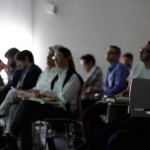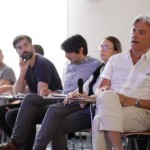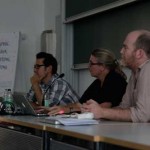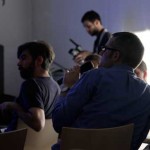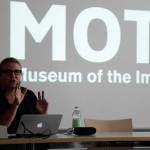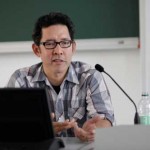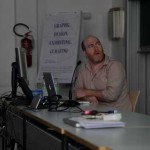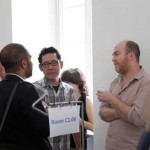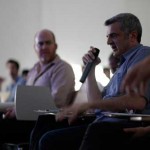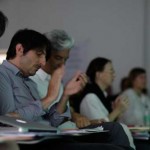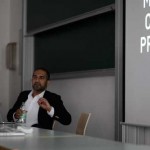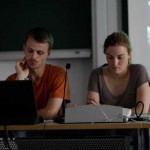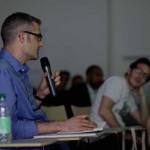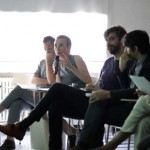Some shots and quotes from the conference Graphic Design, Exhibiting, Curating that we organized on June 26. A publication including the talks and extracts from the discussion will follow in Autumn-Winter 2012.
«People who disagree with the exhibition of graphic design give the argument, among others, that graphic design is about context, and the exhibition of graphic design – the creation of an artificial setting – goes against its function. In my case, I interpret the context of a graphic design exhibition as a way to reactivate the objects through a critical or artistic prism, as an exercise of formatting a new space of existence for the designed objects.
The format of the exhibition can thus provide books, posters, or other artifacts an extended life that allows to approach them by posing new issues that cross and engage different disciplines and actors – artists, theorists, designers, etc.»
Charlotte Cheetham (Manystuff.org)
«We founded Lungomare, first, because we felt it a necessity to open up a space for discussion and interaction, where dialogue can take place. The aim was, and still is, to open up the meaning of design, and not to practice it as a discipline that stands alone. … In the projects that we organize we want to figure out how design scope can extend. … Instead of fulfilling expectations, we are much more interested in creating expectations, and in inviting the spectators to discuss them within a larger frame. … The projects of Lungomare aim at creating a more immediate relation with the public, and at sharing moments of reflection and negotiation. …
The nature of graphic design is a process of dialogue, analysis, research, editing, curating and organizing.
We always work with a large network of people. We do curate projects and invite other people to curate projects. We do a lot of discussions, and conferences. Lots of projects also leave the city context behind and try to engage the wider geographical context.»
Lungomare / Lupo&Burtscher
«When given the possibility to exhibit our work, we more and more tend to bend, in the sense of mooding, adapting or appropriating the spaces and the other resources that are at hand. And this sort of occasions becomes moments of collective learning and production. …
We think that in a moment in which more and more attention is being given to the exhibition of design works, there is a real chance for re-thinking how the moment of the exhibition can support projects that are built on the assumptions that as designers we need and we can imagine other ways of relating to each other, other value practices, and other ways of working and interacting with the world. Therefore we would like to pose the question of how the various possible exhibition contexts and the collaboration with institutions and curators can enable as well as push such critically engaged practices.»
Brave New Alps
«I am interested in questions of agency, between curators, exhibition designers and artists, and how some of these roles overlap. Who takes the authority for the exhibition, and how does an exhibition arrives at a kind of confluence of interests? Obviously there are many historical precedents we could talk about. We can talk about El Lissitzky’s Abstract Cabinet, in Hanover [Landesmuseum], 1926-27, that is a very interesting moment when somebody functions not only as the person who creates the display system in order to activate the viewer, but also chooses the works within it, in this social circle of the people that he is working with… for better or worse it is really embeddedness that happens here. What is interesting to me is this focus on activating the viewer, creating a kind of rupture, a way of looking at works that do not claim to be neutral or unmediated.»
Prem Krishnamurthy (Project Projects)
«When I started the gallery, The Narrows, there was not clear objective of what I would show. It was an evolving project. … A lot of projects were driven by the idea that as a child I never thought I actually would travel to Europe; so I was always really excited when I would see a record cover or a magazine with a work from a Swiss designer, or a Josef Müller-Brockmann book, for example. So the gallery itself was a sort of crusade to bring European artwork to Melbourne.»
Warren Taylor (The Narrows)
«Over the past ten years I have been organizing nine exhibitions, as I said earlier. Just gone out of schools, I did not have much work… I did not take it very seriously, in fact it was rather the social aspect I was interested in: I liked the idea of bringing people together to discuss design and different kind of works. This was the motivation, rather than wanting to be a curator – and in fact I feel rather uncomfortable calling myself ‘a curator’ sometimes, since I feel I am like an amateur. Anyway, I am going to introduce this exhibition called Wide White Space, which I curated about a year and a half ago at the Wattis Institute. The show is an exhibition about exhibitions, designers working on exhibitions. My early motivation for doing this exhibition was really selfish in a way, because it is about what I do, and I saw it as an opportunity to really conducting research and look into this interesting area which I think is a fruitful area for graphic designers to practice. This exhibition particularly focused on graphic designers who create work in the following three areas: identity for exhibiting institutions, designers who forge collaborations with curators and artists, and designers who launch their own-based exhibition initiatives.»
Jon Sueda (CCA)
«Now we are here: a new generation of professionals, artists and designers are coming of age. They grew up with mobile phones, Internet, and virtual worlds. Technology is a fundamental part of their culture and identity. This new generation is actually not so busy in creating its own visual language, they work with templates and software that determine what they create. I think this is rather the future of graphic design. This is also the reason that I am changing the museum a little bit. Graphic design is disappearing because the diverse disciplines are merging. And so I changed the name of the museum from Graphic Design Museum to MOTI, Museum of the Image. And of course MOTI has a strong connection with the world of information and media, which comes from graphic design but goes towards what I call the ‘future of graphic design’, that is visual culture or image culture. … Graphic design has transformed into a varied contemporary media world. What was supposed to be a small and craft-based profession called ‘graphic design’, has become in the twenty-first century a very popular and democratised discipline at the center of art and media. And technology develops further. We have no rules any more. We are departing from the graphic profession as it developed in the 1970-80s. We are now part of the explosion of image culture, a bombardment of visuals all around us. Technology creates a culture for the mass.»
Mieke Gerritzen (MOTI Breda)
